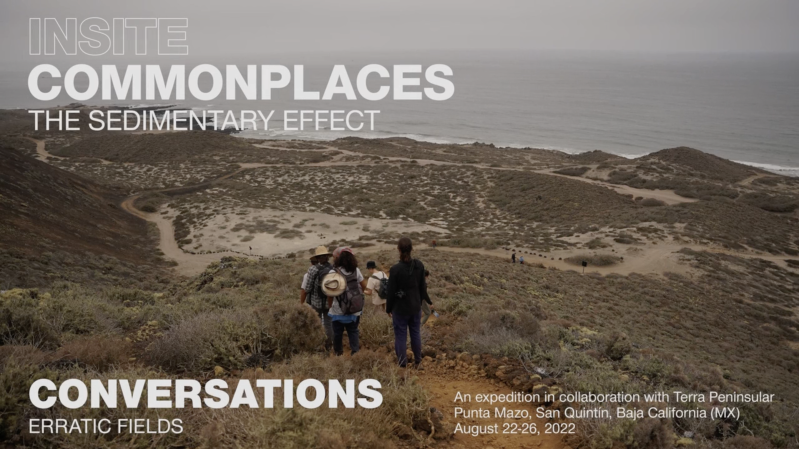The second chapter, “Erratic Fields,” interweaves specific chronicles of geological and natural phenomena from Baja California and San Diego with the practice of artists who have been exploring wind, sediments, rivers, and the politics of landscape. The chapter began with an invitation to artists and curators from Mexicali, Ensenada, and San Diego to engage in research and peripatetic Conversations at Punta Mazo in San Quintin, BC, an area where groups of the first hunter-gatherers lived, and the site of extinct volcanoes, coastal dunes, native flora and fauna, and artisanal fishing farms, all in the Pacific Ocean. The excursion was led by naturalists from Terra Peninsular who prepared special hikes, walks, and activities for the group to explore the history, economy, and ecology of this place, which shares a coastline with the rest of Baja California and California. Group conversations were held each night through specific questions and readings focused on geography, scale, the nomadic and the sedimentary, as well as oral presentations of participants’ recent projects. The conversations and interviews have evolved into new commissions as well as texts for the upcoming INSITE Journal dedicated to “Erratic Fields.”
Participants in the Conversations included: Alex Bazán (Ensenada), Isabel Casso (San Diego), Johnnie Chatman (San Diego), Lael Corbin (San Diego), Carmen Cuenca (San Diego-Tijuana), Rosela del Bosque (Mexicali), Periférica Educativa Experimental (César Noyola and Teresa Tavera) (Ensenada), Liz Stringer (San Diego), Terra Peninsular (Claudia Guzmán and Mirna Borrego) (San Quintín), Andrea Torreblanca (Ensenada), and Pastizal Zamudio (Mexicali).
Microhistories featured in this chapter include the Santa Ana winds, a phenomenon in which hot air originates in the Grand Basin of Nevada and travels to Southern California and the north of Baja California, causing fires, shifting ocean currents, and affecting some people psychologically. Lael Corbin, a San Diego-based artist who has “wrestled” with the wind for many decades through sculptures and performance, is currently working on a Commission centered on these unique winds.
Another story from this chapter involves American artist Donald Judd’s camping trips with his family to Baja California in the late 1960s and early ’70s. After finding a site in El Rosario, he conceived the design for a large-scale work in the form of a house that was never built, but would be reflected in later works in Marfa, Texas. Alex Bazán, an artist from Ensenada, BC, is researching Judd’s travels while working on a new Commission in a landscape in his hometown, where his family's house was destroyed by the contruction of a municipal dam after a historic floods.
For the In Focus section of the “Erratic Fields” INSITE Journal, two texts have been commissioned with Conversations participants: the first to San Diego-based artist, theorist, and researcher Johnnie Chatman, who is interested in the reductionist legacy of the American western landscape in relation to Black history; the second to curators Rosela del Bosque and Jessica Sevilla from Mexicali, who is interested in restoring the history of the Rio Colorado and bodies of water from the area through oral narratives, invocations, and archives—most in collaboration with artists and researchers from the region and beyond.
For the Journal’s Viewpoints section, Ensenada–New York-based artist Livia Corona was interviewed in her Ensenada studio to share the process behind her work, which is closely tied to her family’s genealogy in California and Baja California, and her interest in the concept of land, industry, and the politics of labor. Her current practice focuses on working with the remains of bivalve shells and agricultural polymers from local farms.
Participants
Terra Peninsular _ Periférica Educativa Experimental _ Johnnie Chatman _ Isabel Casso _ Lael Corbin _ Rosela Del Bosque _ Alex Bazán _ Pastizal Zamudio
Erratic Fields expedition
Punta Mazo, San Quintin, Baja California
August 22-26, 2022
In collaboration with Terra Peninsular.


